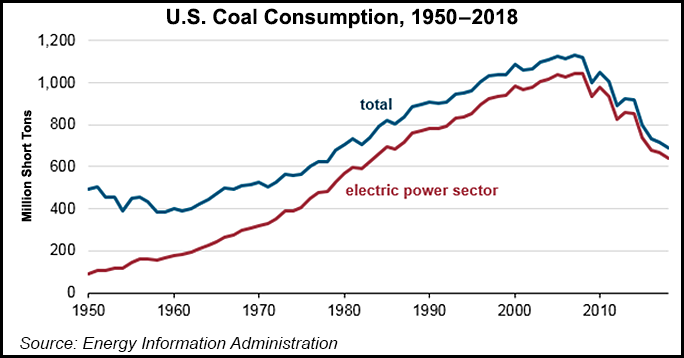NGI The Weekly Gas Market Report | Markets | NGI All News Access
Tempted by Cheap Natural Gas, U.S. Burning Least Coal Since 1979, Says EIA
Amid stiff competition from natural gas and renewables in the power sector, U.S. coal consumption in 2018 is on track to fall to its lowest level since 1979, the Energy Information Administration (EIA) said this week.

In what would continue a down trend that can be traced back to 2007, EIA expects the United States to consume 691 million short tons of coal in 2018, a 4% decline from 2017.
The declines stem from coal-fired retirements and lower capacity utilization rates in the power sector, which has accounted for 93% of domestic coal consumption between 2007 and 2018.
“In 2007, coal-fired capacity in the United States totaled 313 GW across 1,470 generators,” EIA said. “By the end of 2017, 529 of those generators, with a total capacity of 55 GW, had retired. So far in 2018, 11 GW of coal-fired generating capacity has retired through September, and another 3 GW are expected to retire in the final three months of the year, based on data reported to EIA by plant owners and operators.
“If these plants retire as planned, 2018 will be the second-highest year for coal retirements. Another 4 GW of capacity are planning to retire by the end of 2019.”
With just one new coal-fired generator expected to come online by the end of 2019 with a “relatively small” 17 MW of capacity, EIA expects coal consumption to decline another 8% year/year in 2019.
Sustained low prices for natural gas amid a surge in domestic production since 2007 has been a key driver of coal’s recent decline, EIA noted. Other factors such as the relative age of coal-fired units, changes in regional electricity demand, and greater competition from renewables have also played a role.
Stricter environmental standards have helped accelerate this decline. Coal retirements peaked in 2015 when the Mercury and Air Toxics Standards Rule went into effect, prompting many smaller plants to shutter rather than invest in emissions control technologies, EIA said.
© 2024 Natural Gas Intelligence. All rights reserved.
ISSN © 1532-1231 | ISSN © 2577-9877 | ISSN © 1532-1266 |
